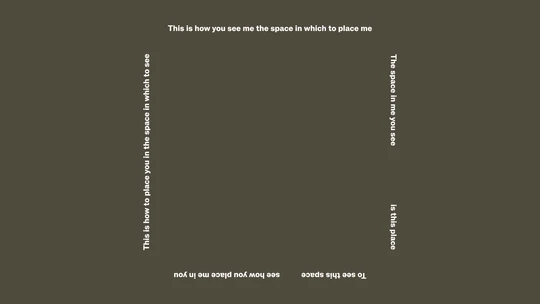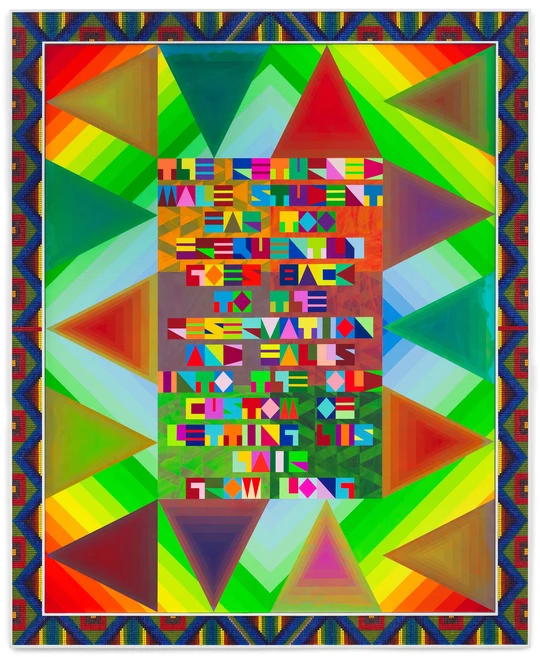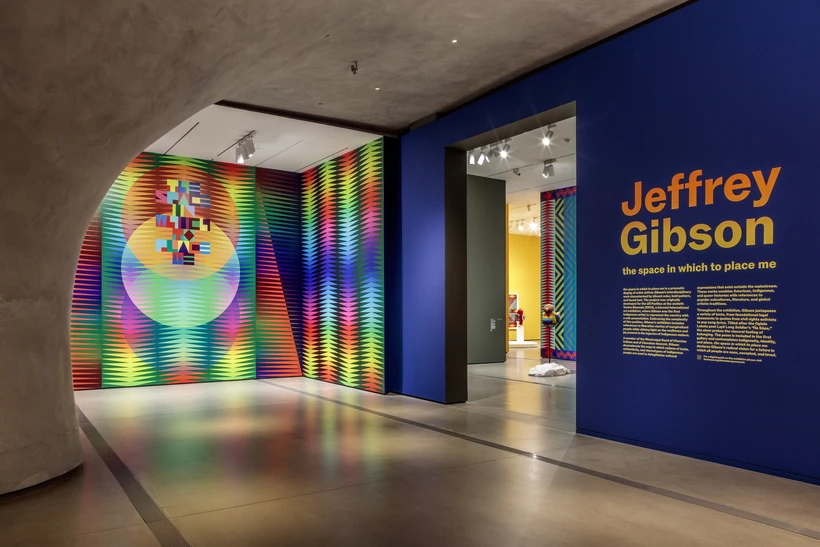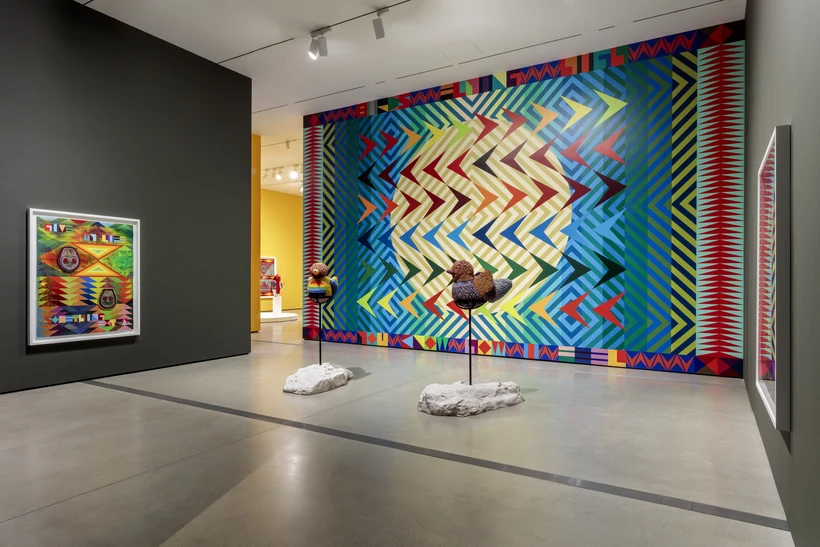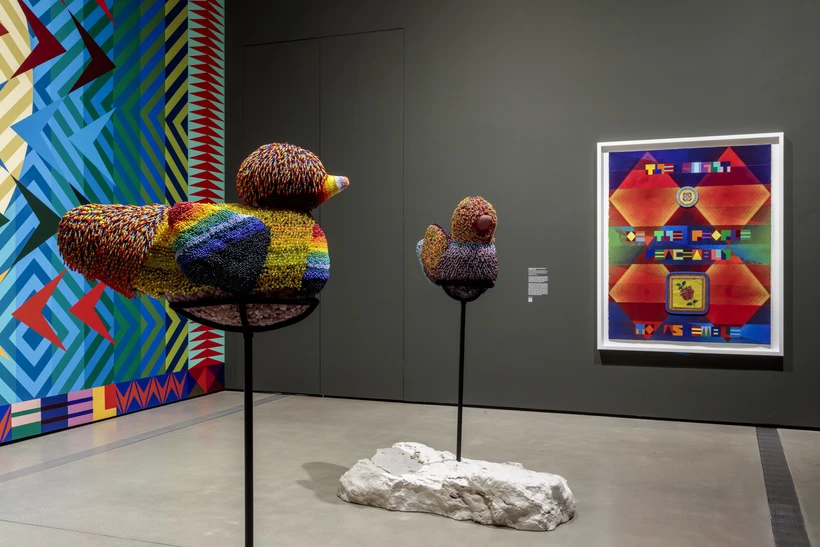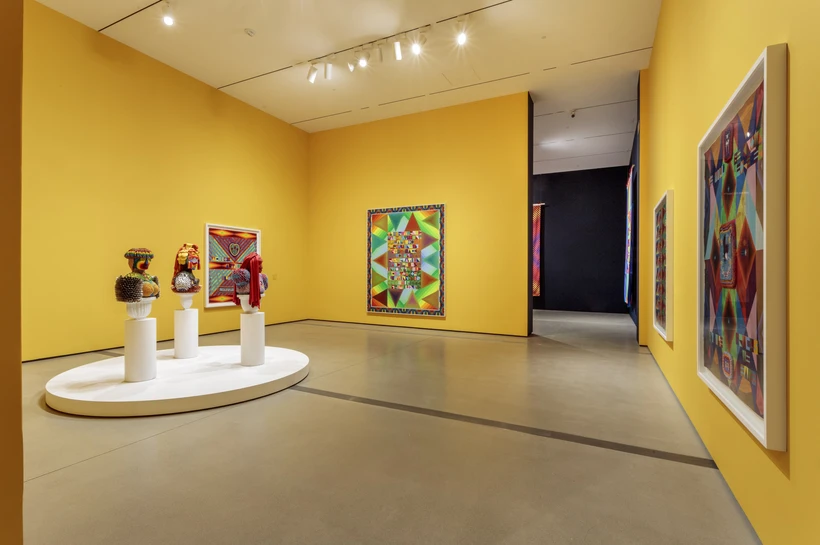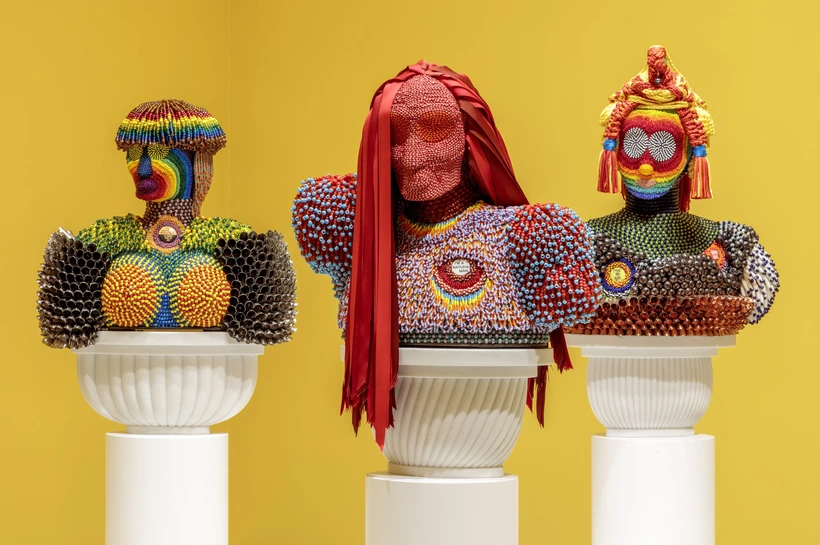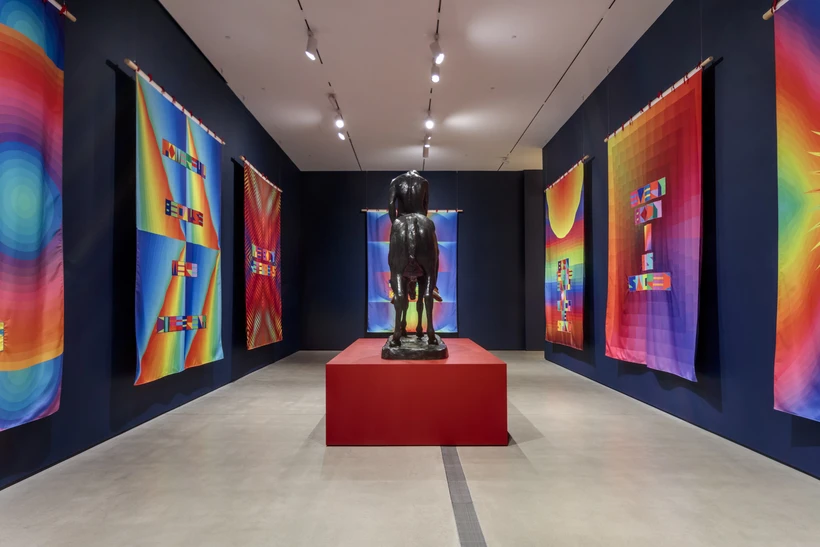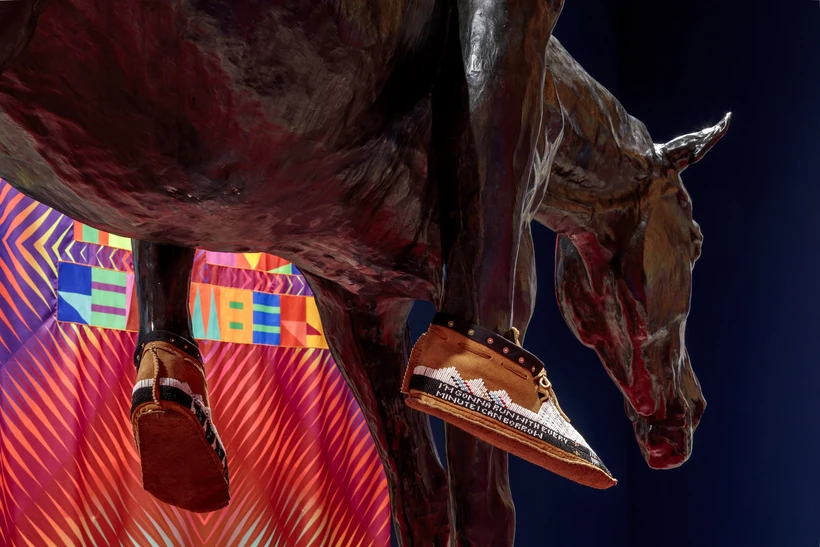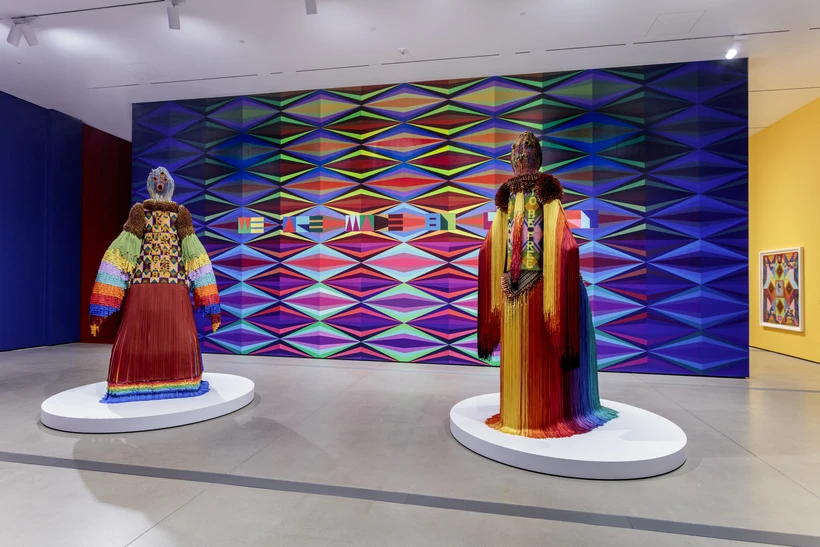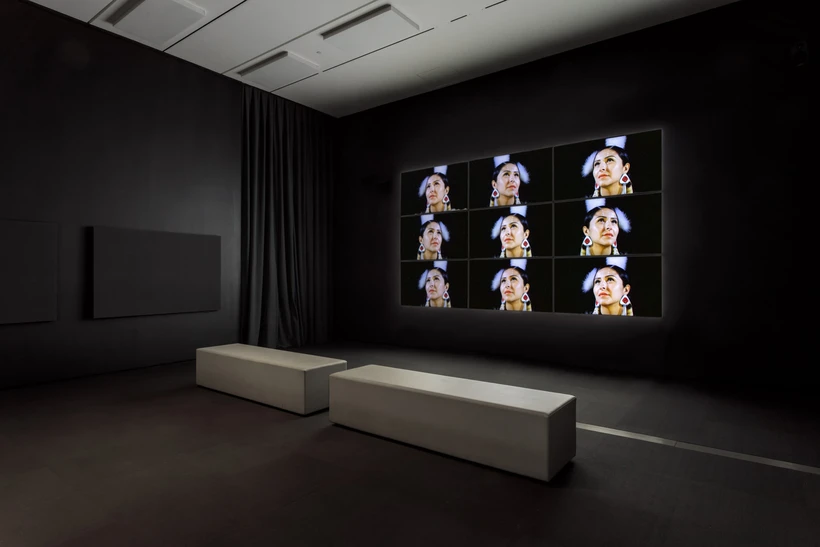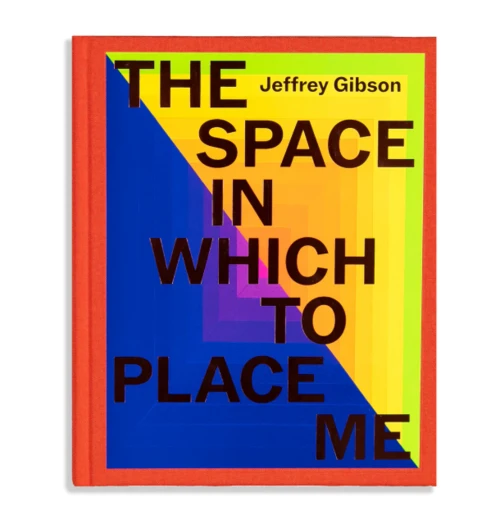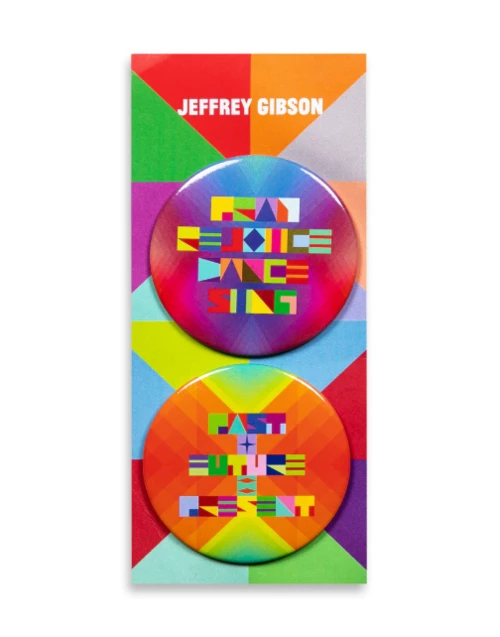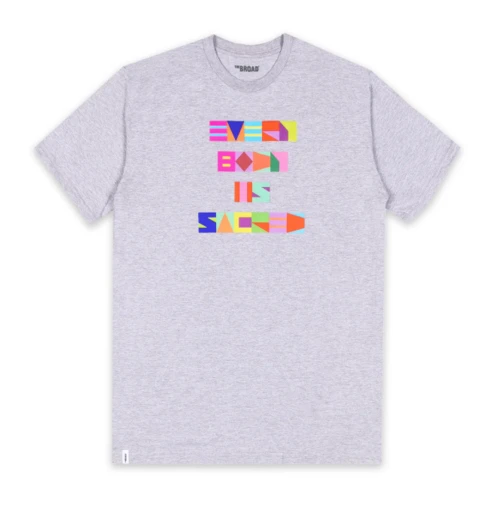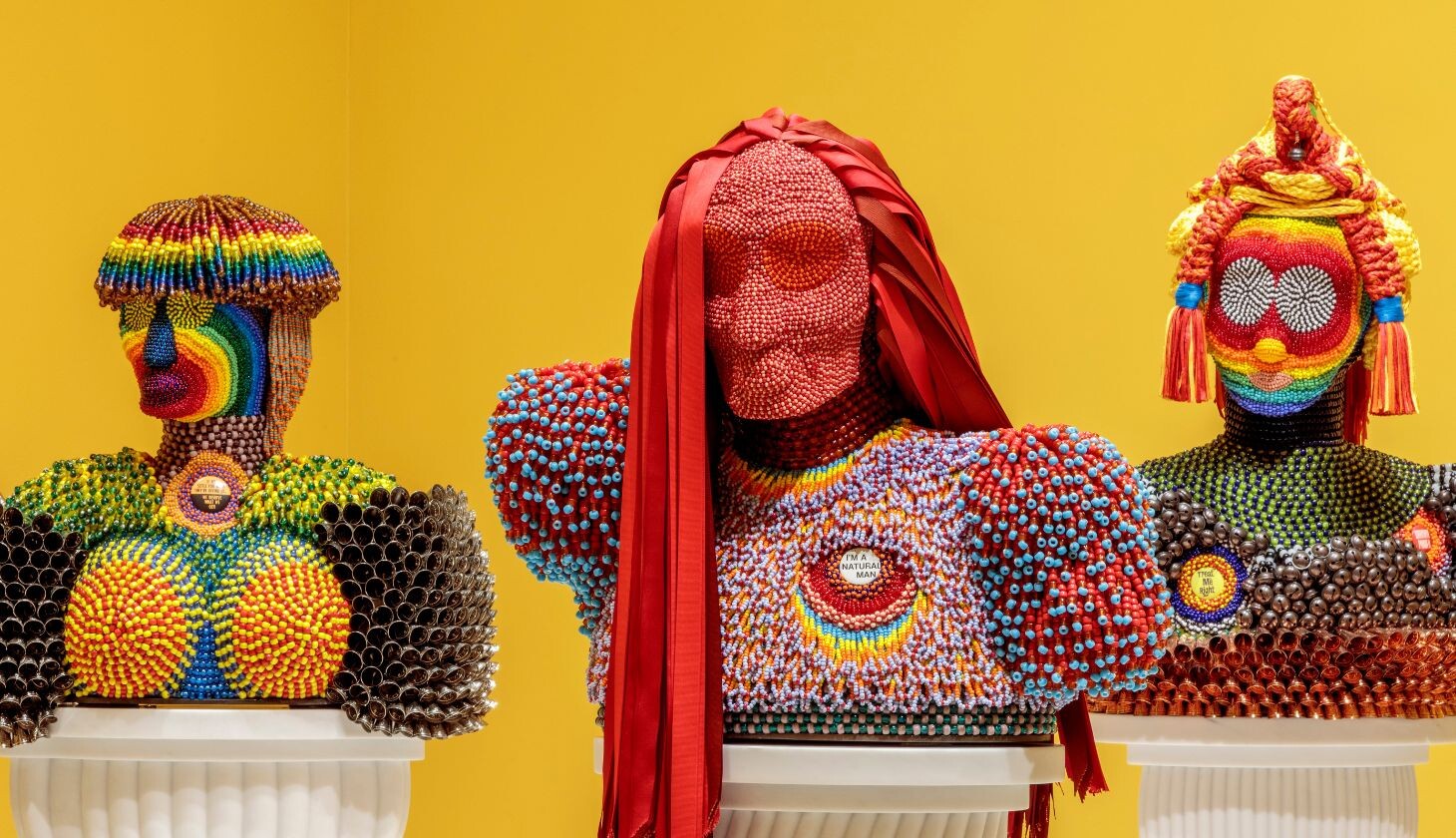
Jeffrey Gibson: the space in which to place me
Jeffrey Gibson: the space in which to place me is a kaleidoscopic special exhibition filled with vibrant colors, intricate beadwork, towering sculptures, and powerful storytelling, all reflecting the artist’s radical vision for a future in which all people are seen, accepted, and loved. The show comes to The Broad directly from the 60th Venice Biennale (2024), one of the most prestigious exhibitions of visual art in the world, where Gibson made history as the first Indigenous artist to represent the United States with a solo show at the US Pavilion.
Gibson’s practice celebrates individuals and communities who have maintained their dignity and traditions in impossible circumstances, centering the resilience present in the legacies of Indigenous makers. He juxtaposes a variety of texts, from foundational legal...
Jeffrey Gibson: the space in which to place me is a kaleidoscopic special exhibition filled with vibrant colors, intricate beadwork, towering sculptures, and powerful storytelling, all reflecting the artist’s radical vision for a future in which all people are seen, accepted, and loved. The show comes to The Broad directly from the 60th Venice Biennale (2024), one of the most prestigious exhibitions of visual art in the world, where Gibson made history as the first Indigenous artist to represent the United States with a solo show at the US Pavilion.
Gibson’s practice celebrates individuals and communities who have maintained their dignity and traditions in impossible circumstances, centering the resilience present in the legacies of Indigenous makers. He juxtaposes a variety of texts, from foundational legal documents to quotes from civil rights activists to pop song lyrics, combining American, Indigenous, and LGBTQ+ histories with references to popular subcultures, literature, and global artistic traditions.
Free Access
You can see Jeffrey Gibson: the space in which to place me for free every Thursday evening from 5 to 8 pm and on Friday, September 26, in honor of California Native American Day. Special exhibition tickets for visitors 17 years old and under are always free.
Bring a friend, drop in after work, or make it a date night—no cost, just community, art, and a chance to see Gibson’s bold and vibrant works that celebrate Indigenous identity, joy, and collective strength.
About the Exhibition
Jeffrey Gibson: the space in which to place me is Gibson’s first solo museum show in Southern California. The exhibition borrows its title from the Oglala Lakota poet Layli Long Soldier’s poem “Ȟe Sápa,” which contemplates Indigeneity, identity, and place using a playful geometric format. Across prismatic murals, bold paintings and sculptures, and an electrifying video installation, Gibson honors the multiplicity of identity.
Gibson’s work reflects his admiration and respect for the generations of Indigenous makers who have come before him, situating his work within art histories that have previously excluded Native artists, and in the footsteps of postwar painters and printmakers such as Corita Kent, Jean-Michel Basquiat, Jaune Quick-to-See Smith, and Andy Warhol. Gibson uses recognizable language and images to challenge preconceived assumptions and stereotypes.
I make work that’s very much about being a living being in this world, which I see as phenomenal. And I wish for people that they could understand how phenomenal the world around us is.
— Jeffrey Gibson for the Los Angeles Times
New Acquisitions
The Broad has acquired Gibson’s 2024 painting THE RETURNED MALE STUDENT FAR TOO FREQUENTLY GOES BACK TO THE RESERVATION AND FALLS INTO THE OLD CUSTOM OF LETTING HIS HAIR GROW LONG, which was first presented at the Venice Biennale. Incorporating his signature use of patterned text, radiating color, and glass beads, the painting directly quotes a letter written in 1902 by the Commissioner of Indian Affairs to a school superintendent in Central California, urging Native school children to cut their hair and assimilate into white Eurocentric modes of dress and appearance. The painting transforms historical oppression into both an opposition to tyranny and a celebration of cultural identity.
Gibson first presented She Never Dances Alone, The Broad's second acquisition, with Times Square Arts where the work occupied over 60 digital billboards in Times Square, immersing viewers in the psychedelic experience of watching Sarah Ortegon HighWalking (Eastern Shoshone and Northern Arapaho), wearing jingle dresses of her own making, multiplying seemingly infinitely while dancing to the song “Sisters” by the First Nations electronic music group, the Halluci Nation. The nine-channel video installation presents Ortegon HighWalking engaging traditional Jingle Dancing, originated by the Ojibewea tribe over a century ago, during a time when Indigenous cultures were suppressed and dancing was outlawed. The Jingle Dance continues to be performed by women on the intertribal powwow circuit, with dancing as a mode of reaching out to ancestors for healing and strength. Describing the work, Gibson said he wanted to “draw attention to the importance and strength of Indigenous women.”
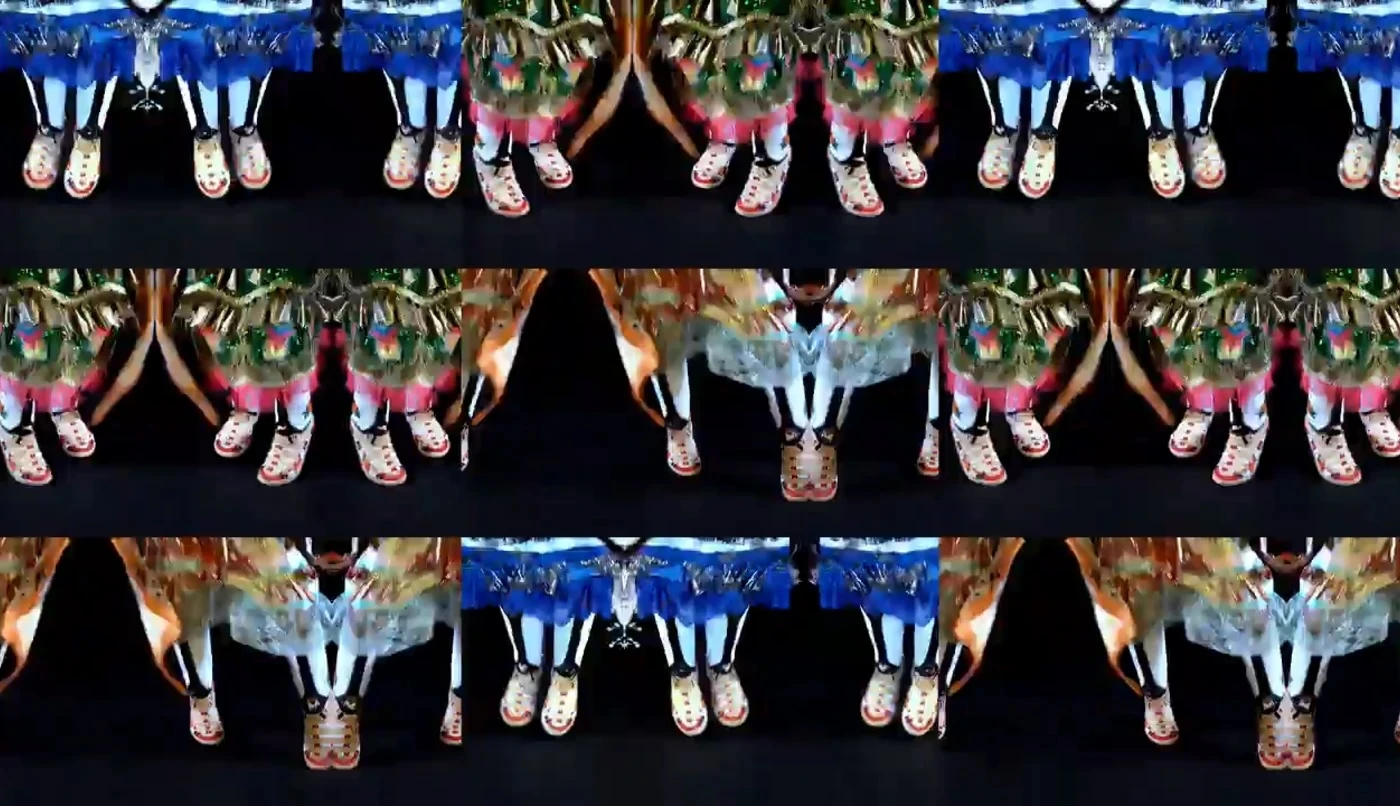
Press Highlights
The Art Newspaper
"His exhibition . . . celebrates the survival of marginalized folks in the face of injustice or violence, with historical quotes embedded in dazzling artworks and used as their titles. Now he is bringing that sense of visual abundance to a broader US audience, including more Native Americans, he hopes."
Hyperallergic
"Opening at the Broad in May, the exhibition will include dozens of works featuring the artist’s telltale colorful geometric patterning and stylized text."
Los Angeles Times
"His exuberant, color-saturated installation serves up an abundance of beauty, awe, astonishment and fun. It stimulates the senses and inspires the mind. Most of all, it uplifts."
Huffington Post
"[Gibson's] take on America’s histories is a vibrant act of resistance"
Spectrum 1 News [video]
"Indigenous artist's bold vision takes center stage at The Broad"
Forbes
"Gibson’s work offers up a joyous explosion of color mixed in masterful patterns that incorporate Indigenous craftwork and traditions as well as text and titles resonant of US history and American pop culture."
Interview Mag
Jeffrey Gibson in conversation with Michèle Lamy
Artist Bio
For over two decades, interdisciplinary artist Jeffrey Gibson (American, born 1972) has evolved an aesthetic that examines our armatures of meaning, from language and text to pattern and music, and how they act as interlocutors with the world around us. His work has been exhibited across the U.S. and internationally, including at the 60th Venice Biennale (2024) where, as a member of the Mississippi Band of Choctaw Indians and of Cherokee descent, he was the first Indigenous artist to represent the country with a solo exhibition at the U.S. Pavilion. Gibson’s artistic practice combines Native art traditions with the visual languages of modernism to explore the confluence of personal identity, popular culture, queer theory, and international social narratives. Across sculpture, painting, and collage, Gibson’s multi-disciplinary work embraces ideas of hybridity and reveals intersections between contemporary issues and past histories.
This biography is adapted from materials from Gibson's 60th Venice Biennale exhibition, the space in which to place me.
Credits
Jeffrey Gibson: the space in which to place me was first presented by Portland Art Museum, Oregon, and SITE Santa Fe, New Mexico at the United States Pavilion of La Biennale di Venezia, the 60th International Art Exhibition (April 20, 2024 through November 24, 2024); commissioned by Louis Grachos, Phillips Executive Director, SITE Santa Fe; commissioned and curated by Kathleen Ash-Milby, Curator of Native American Art, Portland Art Museum and Abigail Winograd, Independent Curator. The Broad’s presentation is organized by Sarah Loyer, Curator and Exhibitions Manager, with the participation of Abigail Winograd.
In Venice, the space in which to place me was made possible by the Bureau of Educational and Cultural Affairs of the U.S. Department of State and was supported by the following philanthropic partners: presenting support by Ford Foundation and Mellon Foundation; Leadership support by MacArthur Foundation; Major support by Agnes Gund, Arison Arts Foundation, Carl & Marilynn Thoma Foundation, The Hearthland Foundation, Henry Luce Foundation, Sotheby's, Terra Foundation for American Art; Generous support by Anonymous, Becky and David Gochman, Bloomberg Philanthropies, Laurie M. Tisch Illumination Fund, Lisa Domenico Brooke, The Pollock-Krasner Foundation, The Robert Lehman Foundation, The Rockefeller Brothers Fund, Sakana Foundation, The Schmidt Family Foundation, The Teiger Foundation; Educational partners and program support by Institute of American Indian Arts, Bard College, Crystal Bridges Museum of American Art, Smithsonian's National Museum of the American Indian; Essential support by A&L Berg Foundation, David Bolger, Deborah Beckmann and Jacob Kotzubei, Dior, Elysabeth Kleinhans, The George Economou Collection, Laura Donnelley, Margaret Morgan and Wesley Phoa, Nicolas Berggruen Charitable Trust, Pamela and David Hornik, Pat and Leona Green, Regina L. Aldisert, Roberts Projects, Sasha and Edward P. Bass, Sikkema Jenkins & Co., Stephen Friedman Gallery, Trellis Art Fund; Sustaining support by Creative Capital Foundation, East West Bank, The James Howell Foundation, PDX Contemporary Art, Vera R. Campbell Foundation, VIA Art Fund; Additional support by Chet Architecture, Ed Cauduro Fund of Oregon Community Foundation, The Fleischner Family Charitable Foundation, Fotene and Tom Cote, Gibert Guaring and Daniel Tobin, Miyoung Lee and Neil Simpkins, The Muriel Pollia Foundation; Sponsors include Anonymous, Delbert Thompson, Dr. Daniel S. Berger, Judith Fried, Lauren Tank, Linda Howe, Lizbeth and George Krupp, Marshall Price, Nancy Gill, Shirley Ash, Tizziana Baldenebro and David Novgorodsky, UBS.
Installation view of Jeffrey Gibson: the space in which to place me at The Broad, Los Angeles, May 10 to September 28, 2025. Photo by Joshua White/JWPictures.com
Exhibition title © Layli Long Soldier, Whereas (2017), courtesy of Graywolf Press.
Jeffrey Gibson, THE RETURNED MALE STUDENT FAR TOO FREQUENTLY GOES BACK TO THE RESERVATION AND FALLS INTO THE OLD CUSTOM OF LETTING HIS HAIR GROW LONG, 2024. Acrylic on canvas, glass beads, plastic beads, inset in a custom wood frame. The Broad, Los Angeles. Courtesy of Jeffrey Gibson Studio. Photo by Max Yawney
